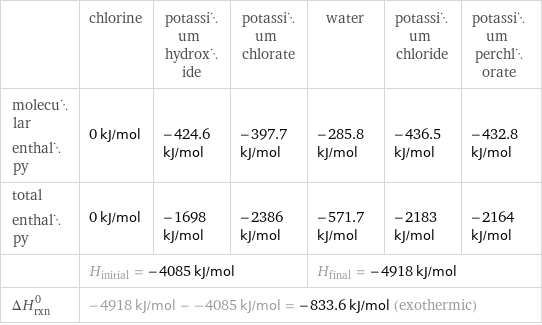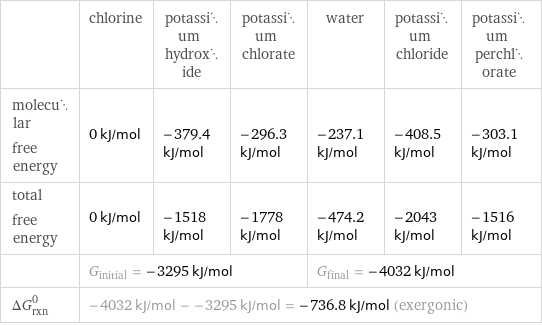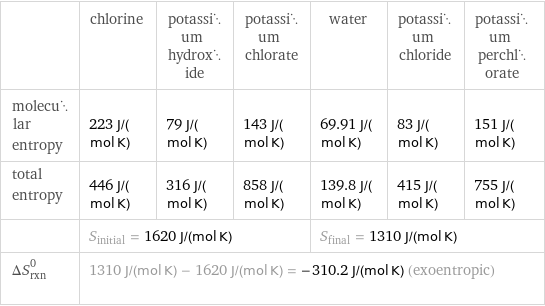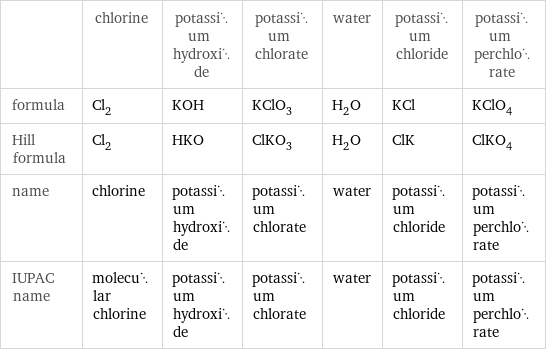Input interpretation

Cl_2 chlorine + KOH potassium hydroxide + KClO_3 potassium chlorate ⟶ H_2O water + KCl potassium chloride + KClO_4 potassium perchlorate
Balanced equation

Balance the chemical equation algebraically: Cl_2 + KOH + KClO_3 ⟶ H_2O + KCl + KClO_4 Add stoichiometric coefficients, c_i, to the reactants and products: c_1 Cl_2 + c_2 KOH + c_3 KClO_3 ⟶ c_4 H_2O + c_5 KCl + c_6 KClO_4 Set the number of atoms in the reactants equal to the number of atoms in the products for Cl, H, K and O: Cl: | 2 c_1 + c_3 = c_5 + c_6 H: | c_2 = 2 c_4 K: | c_2 + c_3 = c_5 + c_6 O: | c_2 + 3 c_3 = c_4 + 4 c_6 Since the coefficients are relative quantities and underdetermined, choose a coefficient to set arbitrarily. To keep the coefficients small, the arbitrary value is ordinarily one. For instance, set c_1 = 1 and solve the system of equations for the remaining coefficients: c_1 = 1 c_2 = 2 c_4 = 1 c_5 = c_3/4 + 7/4 c_6 = (3 c_3)/4 + 1/4 Multiply by the least common denominator, 2, to eliminate fractional coefficients: c_1 = 2 c_2 = 4 c_4 = 2 c_5 = c_3/4 + 7/2 c_6 = (3 c_3)/4 + 1/2 The resulting system of equations is still underdetermined, so an additional coefficient must be set arbitrarily. Set c_3 = 6 and solve for the remaining coefficients: c_1 = 2 c_2 = 4 c_3 = 6 c_4 = 2 c_5 = 5 c_6 = 5 Substitute the coefficients into the chemical reaction to obtain the balanced equation: Answer: | | 2 Cl_2 + 4 KOH + 6 KClO_3 ⟶ 2 H_2O + 5 KCl + 5 KClO_4
Structures

+ + ⟶ + +
Names

chlorine + potassium hydroxide + potassium chlorate ⟶ water + potassium chloride + potassium perchlorate
Reaction thermodynamics
Enthalpy

| chlorine | potassium hydroxide | potassium chlorate | water | potassium chloride | potassium perchlorate molecular enthalpy | 0 kJ/mol | -424.6 kJ/mol | -397.7 kJ/mol | -285.8 kJ/mol | -436.5 kJ/mol | -432.8 kJ/mol total enthalpy | 0 kJ/mol | -1698 kJ/mol | -2386 kJ/mol | -571.7 kJ/mol | -2183 kJ/mol | -2164 kJ/mol | H_initial = -4085 kJ/mol | | | H_final = -4918 kJ/mol | | ΔH_rxn^0 | -4918 kJ/mol - -4085 kJ/mol = -833.6 kJ/mol (exothermic) | | | | |
Gibbs free energy

| chlorine | potassium hydroxide | potassium chlorate | water | potassium chloride | potassium perchlorate molecular free energy | 0 kJ/mol | -379.4 kJ/mol | -296.3 kJ/mol | -237.1 kJ/mol | -408.5 kJ/mol | -303.1 kJ/mol total free energy | 0 kJ/mol | -1518 kJ/mol | -1778 kJ/mol | -474.2 kJ/mol | -2043 kJ/mol | -1516 kJ/mol | G_initial = -3295 kJ/mol | | | G_final = -4032 kJ/mol | | ΔG_rxn^0 | -4032 kJ/mol - -3295 kJ/mol = -736.8 kJ/mol (exergonic) | | | | |
Entropy

| chlorine | potassium hydroxide | potassium chlorate | water | potassium chloride | potassium perchlorate molecular entropy | 223 J/(mol K) | 79 J/(mol K) | 143 J/(mol K) | 69.91 J/(mol K) | 83 J/(mol K) | 151 J/(mol K) total entropy | 446 J/(mol K) | 316 J/(mol K) | 858 J/(mol K) | 139.8 J/(mol K) | 415 J/(mol K) | 755 J/(mol K) | S_initial = 1620 J/(mol K) | | | S_final = 1310 J/(mol K) | | ΔS_rxn^0 | 1310 J/(mol K) - 1620 J/(mol K) = -310.2 J/(mol K) (exoentropic) | | | | |
Equilibrium constant
![Construct the equilibrium constant, K, expression for: Cl_2 + KOH + KClO_3 ⟶ H_2O + KCl + KClO_4 Plan: • Balance the chemical equation. • Determine the stoichiometric numbers. • Assemble the activity expression for each chemical species. • Use the activity expressions to build the equilibrium constant expression. Write the balanced chemical equation: 2 Cl_2 + 4 KOH + 6 KClO_3 ⟶ 2 H_2O + 5 KCl + 5 KClO_4 Assign stoichiometric numbers, ν_i, using the stoichiometric coefficients, c_i, from the balanced chemical equation in the following manner: ν_i = -c_i for reactants and ν_i = c_i for products: chemical species | c_i | ν_i Cl_2 | 2 | -2 KOH | 4 | -4 KClO_3 | 6 | -6 H_2O | 2 | 2 KCl | 5 | 5 KClO_4 | 5 | 5 Assemble the activity expressions accounting for the state of matter and ν_i: chemical species | c_i | ν_i | activity expression Cl_2 | 2 | -2 | ([Cl2])^(-2) KOH | 4 | -4 | ([KOH])^(-4) KClO_3 | 6 | -6 | ([KClO3])^(-6) H_2O | 2 | 2 | ([H2O])^2 KCl | 5 | 5 | ([KCl])^5 KClO_4 | 5 | 5 | ([KClO4])^5 The equilibrium constant symbol in the concentration basis is: K_c Mulitply the activity expressions to arrive at the K_c expression: Answer: | | K_c = ([Cl2])^(-2) ([KOH])^(-4) ([KClO3])^(-6) ([H2O])^2 ([KCl])^5 ([KClO4])^5 = (([H2O])^2 ([KCl])^5 ([KClO4])^5)/(([Cl2])^2 ([KOH])^4 ([KClO3])^6)](../image_source/914c1b5c7b6a7ab7bbeec87d40940b99.png)
Construct the equilibrium constant, K, expression for: Cl_2 + KOH + KClO_3 ⟶ H_2O + KCl + KClO_4 Plan: • Balance the chemical equation. • Determine the stoichiometric numbers. • Assemble the activity expression for each chemical species. • Use the activity expressions to build the equilibrium constant expression. Write the balanced chemical equation: 2 Cl_2 + 4 KOH + 6 KClO_3 ⟶ 2 H_2O + 5 KCl + 5 KClO_4 Assign stoichiometric numbers, ν_i, using the stoichiometric coefficients, c_i, from the balanced chemical equation in the following manner: ν_i = -c_i for reactants and ν_i = c_i for products: chemical species | c_i | ν_i Cl_2 | 2 | -2 KOH | 4 | -4 KClO_3 | 6 | -6 H_2O | 2 | 2 KCl | 5 | 5 KClO_4 | 5 | 5 Assemble the activity expressions accounting for the state of matter and ν_i: chemical species | c_i | ν_i | activity expression Cl_2 | 2 | -2 | ([Cl2])^(-2) KOH | 4 | -4 | ([KOH])^(-4) KClO_3 | 6 | -6 | ([KClO3])^(-6) H_2O | 2 | 2 | ([H2O])^2 KCl | 5 | 5 | ([KCl])^5 KClO_4 | 5 | 5 | ([KClO4])^5 The equilibrium constant symbol in the concentration basis is: K_c Mulitply the activity expressions to arrive at the K_c expression: Answer: | | K_c = ([Cl2])^(-2) ([KOH])^(-4) ([KClO3])^(-6) ([H2O])^2 ([KCl])^5 ([KClO4])^5 = (([H2O])^2 ([KCl])^5 ([KClO4])^5)/(([Cl2])^2 ([KOH])^4 ([KClO3])^6)
Rate of reaction
![Construct the rate of reaction expression for: Cl_2 + KOH + KClO_3 ⟶ H_2O + KCl + KClO_4 Plan: • Balance the chemical equation. • Determine the stoichiometric numbers. • Assemble the rate term for each chemical species. • Write the rate of reaction expression. Write the balanced chemical equation: 2 Cl_2 + 4 KOH + 6 KClO_3 ⟶ 2 H_2O + 5 KCl + 5 KClO_4 Assign stoichiometric numbers, ν_i, using the stoichiometric coefficients, c_i, from the balanced chemical equation in the following manner: ν_i = -c_i for reactants and ν_i = c_i for products: chemical species | c_i | ν_i Cl_2 | 2 | -2 KOH | 4 | -4 KClO_3 | 6 | -6 H_2O | 2 | 2 KCl | 5 | 5 KClO_4 | 5 | 5 The rate term for each chemical species, B_i, is 1/ν_i(Δ[B_i])/(Δt) where [B_i] is the amount concentration and t is time: chemical species | c_i | ν_i | rate term Cl_2 | 2 | -2 | -1/2 (Δ[Cl2])/(Δt) KOH | 4 | -4 | -1/4 (Δ[KOH])/(Δt) KClO_3 | 6 | -6 | -1/6 (Δ[KClO3])/(Δt) H_2O | 2 | 2 | 1/2 (Δ[H2O])/(Δt) KCl | 5 | 5 | 1/5 (Δ[KCl])/(Δt) KClO_4 | 5 | 5 | 1/5 (Δ[KClO4])/(Δt) (for infinitesimal rate of change, replace Δ with d) Set the rate terms equal to each other to arrive at the rate expression: Answer: | | rate = -1/2 (Δ[Cl2])/(Δt) = -1/4 (Δ[KOH])/(Δt) = -1/6 (Δ[KClO3])/(Δt) = 1/2 (Δ[H2O])/(Δt) = 1/5 (Δ[KCl])/(Δt) = 1/5 (Δ[KClO4])/(Δt) (assuming constant volume and no accumulation of intermediates or side products)](../image_source/675d6bf51463c63d1992e0e83bcfa824.png)
Construct the rate of reaction expression for: Cl_2 + KOH + KClO_3 ⟶ H_2O + KCl + KClO_4 Plan: • Balance the chemical equation. • Determine the stoichiometric numbers. • Assemble the rate term for each chemical species. • Write the rate of reaction expression. Write the balanced chemical equation: 2 Cl_2 + 4 KOH + 6 KClO_3 ⟶ 2 H_2O + 5 KCl + 5 KClO_4 Assign stoichiometric numbers, ν_i, using the stoichiometric coefficients, c_i, from the balanced chemical equation in the following manner: ν_i = -c_i for reactants and ν_i = c_i for products: chemical species | c_i | ν_i Cl_2 | 2 | -2 KOH | 4 | -4 KClO_3 | 6 | -6 H_2O | 2 | 2 KCl | 5 | 5 KClO_4 | 5 | 5 The rate term for each chemical species, B_i, is 1/ν_i(Δ[B_i])/(Δt) where [B_i] is the amount concentration and t is time: chemical species | c_i | ν_i | rate term Cl_2 | 2 | -2 | -1/2 (Δ[Cl2])/(Δt) KOH | 4 | -4 | -1/4 (Δ[KOH])/(Δt) KClO_3 | 6 | -6 | -1/6 (Δ[KClO3])/(Δt) H_2O | 2 | 2 | 1/2 (Δ[H2O])/(Δt) KCl | 5 | 5 | 1/5 (Δ[KCl])/(Δt) KClO_4 | 5 | 5 | 1/5 (Δ[KClO4])/(Δt) (for infinitesimal rate of change, replace Δ with d) Set the rate terms equal to each other to arrive at the rate expression: Answer: | | rate = -1/2 (Δ[Cl2])/(Δt) = -1/4 (Δ[KOH])/(Δt) = -1/6 (Δ[KClO3])/(Δt) = 1/2 (Δ[H2O])/(Δt) = 1/5 (Δ[KCl])/(Δt) = 1/5 (Δ[KClO4])/(Δt) (assuming constant volume and no accumulation of intermediates or side products)
Chemical names and formulas

| chlorine | potassium hydroxide | potassium chlorate | water | potassium chloride | potassium perchlorate formula | Cl_2 | KOH | KClO_3 | H_2O | KCl | KClO_4 Hill formula | Cl_2 | HKO | ClKO_3 | H_2O | ClK | ClKO_4 name | chlorine | potassium hydroxide | potassium chlorate | water | potassium chloride | potassium perchlorate IUPAC name | molecular chlorine | potassium hydroxide | potassium chlorate | water | potassium chloride | potassium perchlorate
Substance properties

| chlorine | potassium hydroxide | potassium chlorate | water | potassium chloride | potassium perchlorate molar mass | 70.9 g/mol | 56.105 g/mol | 122.5 g/mol | 18.015 g/mol | 74.55 g/mol | 138.54 g/mol phase | gas (at STP) | solid (at STP) | solid (at STP) | liquid (at STP) | solid (at STP) | solid (at STP) melting point | -101 °C | 406 °C | 356 °C | 0 °C | 770 °C | 400 °C boiling point | -34 °C | 1327 °C | | 99.9839 °C | 1420 °C | density | 0.003214 g/cm^3 (at 0 °C) | 2.044 g/cm^3 | 2.34 g/cm^3 | 1 g/cm^3 | 1.98 g/cm^3 | 2.5239 g/cm^3 solubility in water | | soluble | soluble | | soluble | surface tension | | | | 0.0728 N/m | | dynamic viscosity | | 0.001 Pa s (at 550 °C) | | 8.9×10^-4 Pa s (at 25 °C) | | odor | | | | odorless | odorless |
Units
